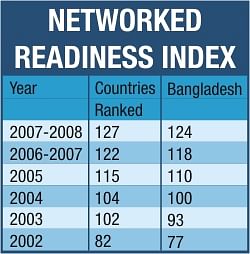Can Bangladesh be Asia's next technology destination?

Bangladesh has yet to benefit from its proximity to India in the field of IT and Outsourcing. Software exports also remain insignificant at just $ 30 million. So why is it that the country has not been able to jump onto the ICT train?
I think there are five major constraints on the growth of a sizeable ICT/ITES industry in Bangladesh.
Firstly there is a lack of skilled labour, secondly high internet costs, that have been slow to fall even after the opening of the submarine cable in 2006, and thirdly the country's poor image, associated with political instability, natural disasters and poverty.
Fourthly there is a lack of credible domestic tech players, with too many small companies (more than 300 companies in a $ 30mn export sector) and none with the ability to meet the demands of the major global multinational outsourcing contracts.
Finally there is ineffective marketing, especially in key client markets such as Silicon Valley.
Given the lack of progress in the IT sector, any reasonable potential investor may question if this reflects an intrinsic inability of Bangladesh to compete in the technology and outsourcing business. Is a sizeable ICT industry mission impossible?
I believe that a number of changes in the global competitive landscape argue that ICT is not just a “thrust sector” by name, but in Bangladesh, it is genuinely a sector at a tipping point with prospects for explosive growth.
Firstly, Bangladesh can benefit from the rapid increases in wage costs in India's IT sector coupled with the appreciation of the Indian Rupee against the USD, a trend that has reduced India's comparative cost advantage. There is also a growing shortage of skilled labour in cities like Bangalore, along with staff retention problems.
Secondly, Bangladesh can take advantage of the increasing concern among leading companies about their heavy dependence on India and their desire to diversify their outsourcing requirements. In the same way that Vietnam benefited from a “China+one strategy”, other Asian countries can position themselves as “India+one” technology providers.
Thirdly, by developing its IT talent pool and breadth of capabilities, Bangladesh can position itself to benefit from “secondary outsourcing” from Indian companies who need an additional supply of labour. Indian IT companies are also looking to expand to a rapidly growing domestic market of 150 million people.
Finally, and perhaps most significantly, Bangladesh has barely tapped the intellectual and commercial capital of the relatively large numbers of Non-Resident Bangladeshis (NRB) working in the technology sector in the US.
I have little doubt that the Bangladeshi diaspora can have the same transformational impact on the domestic IT sector that Non-Resident Indians (NRI) had on India in the 1990s. A large number of NRBs are keen to use their knowledge and business experience to start up more new tech ventures in Bangladesh. Others remain in the US and use their contacts and credible interface with global tech companies to partner with Bangladeshi corporates to market and source deals. What we need is an effective interface and platform for such NRBs to engage in the Bangladeshi technology.
In the past week I attended the BDI/Harvard Conference on Bangladesh Scholars in Boston as well as the American Association of Bangladeshi Engineers and Architects (AABEA) in New Jersey. What resonated with me again was the wealth of NRB intellectual and commercial capital, which if properly harnessed, could have a transformational effect on the growth prospects and trajectory of the Bangladeshi economy.
The problems faced by Bangladesh is not due to the Government not knowing the appropriate steps to create the right environment for a multi-billion dollar IT/Outsourcing sector. Rather it has been a lack of execution, prioritisation and focus.
As an intermediate step to cheapen broadband access for the nation via Wimax technology, the government needs to establish a number of regional technology parks that will offer not just cheap telecommunications, but shared marketing and management support, a tech expertise/training centre and also genuine business incubators. NRBs can return and create new tech business in partnership with existing local tech companies.
In addition, in the spirit of the latest 'trans-national thinking' on leveraging diaspora, NRBs in the US should set up marketing 'front ends' with the right compensation and incentives to market specific Bangladeshi outsourcing/ITES capabilities. This would provide both greater contractual confidence for US and European companies as well as better project management and feedback on customer requirements along with knowledge and technology transfers.
There is nothing inevitable about Bangladesh's emergence as a major technology destination in Asia. But I remain of the view that with the necessary reforms in terms of a focused vocational training programme for IT workers, lower internet costs and more effective leverage of the tech diaspora, net software and ITES export revenues have the potential to move from around $ 30 million currently to in excess of $ 1bn in a 5 year period.

 For all latest news, follow The Daily Star's Google News channel.
For all latest news, follow The Daily Star's Google News channel. 




Comments